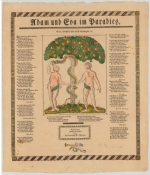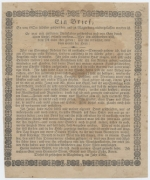Research, Teaching, and Learning Suggestions for Broadsides
- What are Broadsides?
- Suggested Methods for Research, Teaching and Learning
- Resources and Books for further Consultation
Broadsides are posters (image and/or text based) designed to inform or educate the public. They exist in forms such as advertisements, poems, ballads, and public announcements.
"Broadsides are pieces of paper printed on one side, and they were issued to convey messages. Usually published without illustrations or downplaying them in favor of text and vignettes, broadsides were customarily posted in prominent locations for as many people as possible to see. They promoted sales of countless forms of merchandise, announced the arrival of new products, proclaimed when meetings would take place, reminded their readers of current events, and served a host of other purposes. Broadsides were an inexpensive way to reach a wide audience and were a major instrument for communicating before the development of mass media. Truly ephemeral in nature, broadsides were mostly intended for immediate use and then discarded." (Definition by Richard McKinstry from the Ephemera Society of America Website)
Broadsides in contemporary research, teaching and learning
The use of broadsides for research, teaching and learning develops skills such as critical analysis, critical thinking, historical analysis, and textual analysis. The Pennsylvania German Broadsides and Frakturs provide a connection to the past as they "speak for themselves" of events, concerns and issues of the time. They continue to offer possibilities of new inquiry through new input into historical questions. Users should find the broadsides recorded here rich in subject areas such as folklore, religion, hymnology, German language, anthropology, and art. The broadsides expand on what is known about German settlers in the Middle Atlantic region. As Wellenreuther notes, "They suggest settlers were consciously developing their own German-language world -- in religious as well as political and economic terms -- within a larger English-language culture. They strongly indicate continuous, vivid ties between North America and the key regions from which the Germans came, particularly Württemberg and Baden. They supply material for the rewriting of radical pietistic thought, on the one hand, and for a description of the settlers' remarkable aloofness from established churches like Lutheranism or the Reformed church on the other."
TIPS: Google translate is a helpful tool for translating German to text to any language needed. In addition, see this fraktur chart developed at Yale's Irving S. Gilmore Music library for help in deciphering fonts.
Suggested Methods for Research, Teaching and Learning
This guide is offered only as a suggested reference for using this collection. Below are process-oriented, methods-based strategies geared to emphasize useful patterns of thinking. Since research, teaching, and learning are complementary outcomes, these strategies are likely to overlap when put in practice.
Research
Suggested methods of analysis: Question what you see.
- What kind of document is it? What do you observe about it?
- What words do you have difficulty understanding? (make a vocabulary list)
- Are there clues that indicate when was it created?
- Are there clues that indicate where was it created?
- Who created it?
- For what purpose did this person create this document?
- Who was the intended audience?
- How do you interpret what this document says?
- Why do you interpret as such?
- What opinion is the author trying to convey?
- What information is missing?
- What questions does it raise?
Teaching & Learning
Suggested classroom provocations for dialogue: Invite dialogue, paraphrase back what you hear others say
- What do you see?
- What do you see that makes you say that?
- What else can you find?
- What are the physical attributes of this document?
- What does it say?
- What makes you say that?
- What does it not say?
- What is or was its role?
- How is it arranged?
- What do you know about the situation and time period, and the people and objects depicted?
- What questions does this raise?
- How is it related to other materials you have seen?
- How do your answers relate?
Asking Questions and provoking dialogue about an object can provide alternative perspectives and stimulate others to see what they cannot or will not see alone
The Benefits of Thinking Aloud
"In think-alouds, teachers make their thinking explicit by verbalizing their thoughts while reading orally. . . Students will more clearly understand the strategies after a teacher uses think-alouds because they can see how a mind actively responds to thinking through trouble spots and constructing meaning from the text" (Vacca and Vacca 1999, p. 53).Think alouds make text and thought audible, providing a way for social and individual learning experiences.
Adapted from Vacca, Richard, and JoAnne L. Vacca. Content Area Reading. HarperCollins College Publishers, 1993
See also: Visual Thinking Strategies
Websites
- German American Resources at Indiana University
- Max Kade German-American Center
- Index of German American Libraries and Archives
- Researcher's Toolbox from the Library of Congress
- Franklin and Marshall Selected Bibliography
- The Historical Society of Pennsylvania provides a valuable resource for teachers and students on German Settlement in Colonial Pennsylvania. Here is an overview of it.
Books
- Russell and Corinne Earnest: Flying Leaves and One Sheets: Pennsylvania Broadsides, Fraktur and Their Printers Oak Knoll Books New Castle, Delaware 2005
- Don Yoder: The Pennsylvania German Broadside: A History and Guide
- The Pennsylvania German Broadside: A History and Guide by Don Yoder. Introduction. The Broadside in Germanic Europe The invention of printing with movable ...
- Selected Bibliography on German-American Broadsides and Fraktur
- The Pennsylvania German broadside : a history and guide. University Park, PA:. Pennsylvania State University Press for the Library Company of Philadelphia ...
- Pennsylvania Magazine of History and Biography
- The Pennsylvania German Broadside: A History and Guide, by Yoder, rev., 214–15. Pennsylvania Historical Commission, 266, 267, 269, 270 ...
- The Max Kade Institute German-American Research Series
- Editor: A. Gregg Roeber This series provides an outlet for books that reflect the mission of the Penn State Max Kade Institute: to integrate the history and culture of German-speakers in the Americas with the major themes of early modern scholarship from the sixteenth century to the early nineteenth century.


